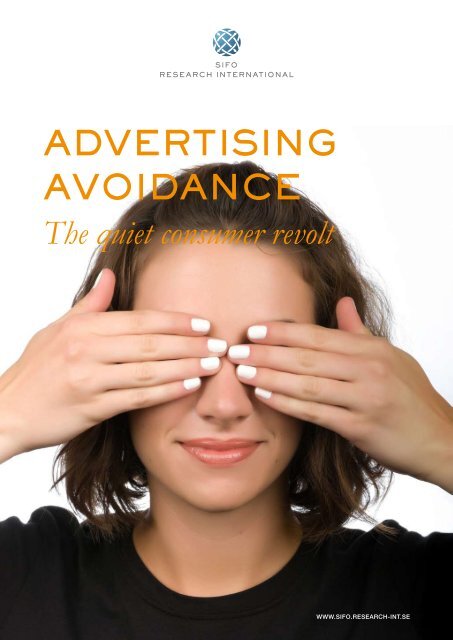Advertising Avoidance - WPP.com
Advertising Avoidance - WPP.com
Advertising Avoidance - WPP.com
You also want an ePaper? Increase the reach of your titles
YUMPU automatically turns print PDFs into web optimized ePapers that Google loves.
From broadcast to narrowcastBut what is it that has really happened; what is it that haschanged? Accelerating technical development coupledwith increasing individualization, diversification and anever more heterogeneous and less static and predictablesociety, has led to ever more personalized products andmedia.In other words, for a great number of years, we havebeen getting more and more, smaller and smaller andmore niche and specialist media to choose from. At thesame time, we have remained people with the same limitedcapacity and mental bandwidth for receiving, digestingand making decisions regarding all the new choicesthat society is providing us with.The whole country no longer gathers in front of the,before, only talk show available on the TV on Saturdaynights in order to have a <strong>com</strong>mon subject of conversationduring the coffee break on Monday morning. Thedigital camp fire has been put out, and we have gonefrom broadcasting to what is now called narrowcasting.The fragmentation and niche development of media hasbeen born of an increasing trend of individualization<strong>com</strong>bined with galloping development of technology.This has produced technical and <strong>com</strong>mercial opportunitiesfor more and more media.Over a fairly short period of time, we have gone from asociety partly characterized by shortages and rationing,where most people followed the path that had alreadybeen staked out for them, to a society where the constantlyincreasing number of choices and alternativesgive us a feeling that there is never enough time for allthat we want to do - despite living longer and workingshorter hours than perhaps ever before.“… can anything actually beheard if everybody is shoutingat the same time?”Ever easier to reach out and ever moredifficult to reach inWe regularly see reports describing how many <strong>com</strong>mercialmessages a consumer encounters each day. Thenumber varies from country to country and from surveyto survey, but one result appears to be crystal clear andirrefutable – the number just keeps on growing. Themost <strong>com</strong>mon figure mentioned is that, each day, we arereached by 1,500 <strong>com</strong>mercial messages.We have moved into a new world, where the opportunitiesof marketers to reach out to consumers are greaterthan ever. Hot air balloon advertising, scent-enhancedcinema advertising, advertising on invoices and, unlessI remember wrongly, the MD of a media <strong>com</strong>pany recentlyoffered his shaven head as an advertising spot(talk of personalized marketing to a specific target group!).But paradoxically, all these new opportunities to reachout have resulted in a world where it is more difficultthan ever to actually force a way through and reach in.For even if the normal methods among advertisers havebeen to shout louder, consumers have increasingly closedtheir ears, and the question remains: can anythingactually be heard if everybody is shouting at the sametime?A quiet consumer revoltEven if the reflex reaction of marketers to raise theirvoices in order to be heard above the others and toforce their way through the noise has not always achievedthe result hoped for, it has still led to consequencesamong consumers.We could call it a kind of advertising revolt, a consumerrevolt on the quiet.The new revolutionaries are, however, not equippedwith paving stones or torches; they are not breakingdown shop windows or setting fire to advertising hoardings.The barricades and the barriers built are not physical,but mental. They shut off, close down and votewith their feet. They put up “No advertising please”signs on their letterboxes, sign up to the telephone preferenceservice to avoid annoying telephone salesmen,activate spam filters and buy digital hard disk recordersto enable them to choose not to watch advertising.Different types of media create differenttypes of avoidance behaviourThere are many different approaches to studying advertisingavoidance and, irrespective of the approachchosen, it is clear from the start that it is not as simpleas determining that advertising in some media or aimedat certain groups in society no longer works. Understandingthe different forms of advertising avoidance andthe different types of advertising avoiders is much more<strong>com</strong>plex than this, but for that reason a necessary andimportant issue for all marketers.As a consequence of the increasing discussions concerningadvertising avoidance, we started studying the phenomenonin 2005, using what consumers thought aboutadvertising in various media as the starting point.WWW.SIFO.RESEARCH-INT.SE
We wanted to chart the extent to which individuals activelytry to avoid advertising in some media, while theydo not mind advertising in others, or even consciouslylooked for advertising using other channels. On the basisof the research results, we quickly discovered thatthere were two main types of media, which everybodyfamiliar with the terms “lean forward media” and “leanbackward media” will immediately recognize.The lean forward media – characterized by us consumingthem actively and mentally leaning forward, of usourselves reaching out for them and searching out theinformation we are looking for – exhibit considerablylower levels of advertising avoidance. This leads us tothe conclusion that consumers, when consuming thesemedia, not just have control over the advertising, butalso over the time and circumstances in which it is present,which is why the advertising is reasonably felt tobe more well-aimed and less intrusive – in short, morerelevant.We can choose ourselves to put the non-relevant DMmailings straight in the recycling box and save the relevantones to read when we ourselves choose to, andfeel we have time – this scarce modern <strong>com</strong>modity. Thesame applies to a newspaper or magazine: if an advertisementdoes not interest us, we just turn the page, or,conversely, if we are interested in advertisements forsomething in particular, we choose ourselves to turn tothat page or section.When we consume these media, we are also helped byour mental firewall, in the form or “selective perception”,which helps us to filter off, unconsciously, all thatwe do not find relevant or interesting, that does notspeak to us, or appeal to us and that which perhaps isrelevant, but which reaches us at the wrong time.If we look at the classic lean backward media, here representedby radio and television, we see a clear tendencywhere active advertising avoidance is reaching everhigher levels. Here, too, the explanation is logical andconspicuously obvious. These media are characterizedby consumers mentally leaning backward and allow themedia experience to wash over them, by letting themselvesbe searched out instead of actively searching out,and being selected as a group of listeners, a target group,instead of searching out what we want to take partin. In total, this gives us considerably less control overthe advertising experience, over the messages that reachus, as well as the circumstances and point in time.As far as the Internet is concerned, this medium holds abi-polar position. On the one hand, it is by definition a”lead forward” medium, at the same time as large partsof the advertising is of a ”lean backward” character.We are searching for the thing to read or do, while theadvertising is searching us out. Reports from the USAshow that a positive side effect of the current recessionis that advertising noise has reduced on the Internet,with positive consequences for the effect of Internetadvertising. It is worth pointing out that it is in all probabilitynot search marketing, but display advertisingthat consumers are referring to in the survey.
Commercials <strong>com</strong>fortably gives me inforamtion aboutproductsCommercials helps me to choose productsPositive and negative Ad AvoidersIn order to further understand the <strong>com</strong>plex advertisingavoidance, a further statistical model was created.In this, we use statistical analysis to create two groupsbased on their basic views on advertising, and get aninteresting matrix when the analysis is cross-referencedagainst advertising avoidance in the different media.Ad positiveAd Avoiders 21,8 16,8Tradition & Control 30,8 9,8Laid back & Available 15,1 2,6Ad negativeThe different positions can be described in many waysand this might be a reasonable starting point for furtherdiscussion about the issue. The yellow segments are“available” via traditional channels, but then vary inopenness towards advertising, depending on their basicattitude.The blue segments try to keep away from advertisingin traditional media, but do not necessarily have to benegative to advertising in itself.Buy unnecessary things because of <strong>com</strong>mercialsIf we were to try to describe each segment using onlyone sentence, the sentences would sound somethinglike this:■ Ad Avoiders/Positive to advertising”I actually quite like advertising, but it feels as though there is abit too much now.”■ Tradition & Control/Positive to advertising“I like the fact that advertising can help me, but I would like tohave control over when, where and how I am exposed to it.”■ Laid back & Available/Positive to advertising“Just pile it on, the more the better – advertising is useful and funand there is no reason not to enjoy and partake of it.”■ Ad Avoiders/Negative to advertising“Don’t want to see – don’t want to be influenced – keep the nuisanceaway from me.”Commercials misleads the public■ Tradition & Control/Negative to advertising“It’s not the case that I like most things, but as long as I’m directingthe experience myself it might be OK.”■ Laid back & Available/Negative to advertising“Well, it’s not that I like it, but I don’t mind partaking of theadvertising.”Once again, this indicates the <strong>com</strong>plexity and need fora more in-depth analysis of each target group. In orderto understand the preconditions we have of succeedingand creating <strong>com</strong>munication that can reach out andreach in, we must understand and behave better in relationto the <strong>com</strong>plex reality in which consumers live.WWW.SIFO.RESEARCH-INT.SE
ORVESTO® KONSUMENTThe information about advertising avoidance is gathered from and analyzed by ORVESTO® Konsument,SIFO Research International’s big media and target group survey. This measures the reachof a large number of media, including newspapers and magazines, ether media, cinema, outdoor advertising,etc. In addition to media information, the databases include thousands of variables of targetgroup character. There is both general information about individuals, such as demography, interestsand habits, and “<strong>com</strong>mercially” interesting parameters, such as spending, as well as matters relatingto bank and insurance, Internet use and visits to shops.SIFO RESEARCH INTERNATIONAL114 78 STOCKHOLM, VISITORS: VASAGATAN 11TEL: +46 (0)8 507 420 00 FAX: +46 (0)8 507 420 01

















